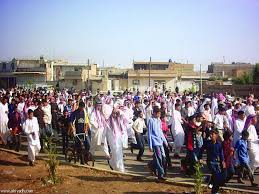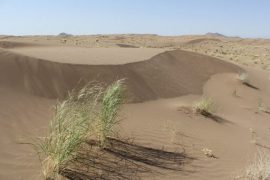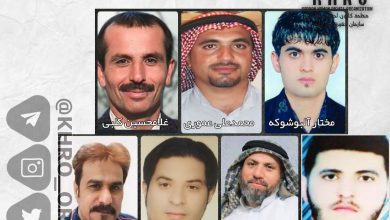
The Ahwaz region, located in what is now southern and southwestern Iran, includes millions of Ahwazis.
The Ahwazi minority is exposed to systematic discrimination and lives below the poverty line and does not have access to adequate health services or clean water.
In the late 1980s, the people of Ahwazi were subjected to a mass exodus as a result of the war between Iran and Iraq, and they were confined to these dilapidated neighborhoods on the margins of Iranian society.
Although the Ahwaz region produces 70 percent of Iranian crude oil and includes most of the Iranian oil fields that constitute the majority of Iranian revenues, the region still suffers from widespread unemployment.
This systematic marginalization practiced by Tehran, in addition to high unemployment rates, reinforces this vicious cycle of poverty.
This fateful cycle, in turn, often leads to the unfortunate but predictable outcome of child labour.
It becomes common for children to abandon their education to seek paid work opportunities to support their families, or in many cases, to find ways to provide for their own clothing and food.
However, this issue is by no means limited to the Ahvaz region, as children across Iran work in terrible conditions, especially in the Iranian capital, Tehran.
It is impossible for most Ahwazi children living in these deprived areas to have at least semi-normal living conditions.
Ahwazi children find themselves forced to stop studying and devote themselves to it, for most of them before they reach secondary education, and often before they learn to read or write.
This creates a feeling of learned helplessness and a “self-fulfilling prophecy,” such that children are afraid to confront authorities.
Some Ahwazi children are forced to search through industrial waste for plastic and glass materials to sell to recycling factories.
Other children sell water by transporting it over long distances in search of buyers.
Some children even accompany street vendors who sell flowers next to often busy traffic lights or at local cemeteries, or offer to wash car windshields.
It is difficult to determine the number of children forced to work, since government authorities or charitable organizations do not publish statistics, and these organizations only monitor children registered with them.
Associations such as “Tolo Mehr Afrinan” provide only about eight dollars a month in addition to a limited number of educational services, which is not enough to alleviate the suffering of these children or their families.
The authors of this article recently met with human rights activists from Ahwaz who specialize in issues related to child labor.
The two activists chose to call themselves by the pseudonyms “Ahmed” and “Adel” to document their meetings with child workers over the past few months.
It is not worth disclosing the names of activists since civil rights groups in Ahwaz are banned and people who express opposition to the horrific mistreatment of this Ahwazi minority group are targeted by the authorities.
It is important to think about the authors’ interview with Ahmed and Adel, as it paints a heartbreaking picture of the mistreatment and human suffering that children are exposed to. The stories of these nine children detailed below represent only a small portion of the hundreds of children working in Ahvaz.
Ahmed conducted interviews with child laborers in one of the poorest and most densely populated neighborhoods on the outskirts of Ahvaz, the capital.
During his visit, Ahmed told the stories of four children from Ahwaz: Laila, Maryam, Musa, and Samer. All of them are no more than thirteen years old, and they work all day in dangerous conditions to help support their families. What he saw can only be described as “desperate generations living in extreme poverty.”
Thus, children work full shifts instead of going to school and enjoying their childhood.
He stresses that seeing children in these conditions is gradually becoming a normal thing and a sight that most Ahwazi residents do not care about.
During a visit by Ahmed to the Beheshtabad cemetery, located on the outskirts of the city of Ahvaz and visited by hundreds of mourners on Thursdays, he met Maryam and Laila, two eleven-year-old twin girls.
Ahmed saw them offering to clean the graves for only a thousand riyals (one American cent). They quickly approached Ahmed because they thought he was one of the mourners, with dirty and bruised hands from cleaning graves all day.
They told him that they clean about 12 graves a day, but that the boys who work at the cemetery are much faster than them and make more money than the girls.
Ahmed was moved as he thought about the reality of these two little girls and their daily suffering.
One of the girls tried to console him and told him: “Don’t cry, we will all die,” and she pointed with her hand to the sky, saying: “We will all go there… to heaven. Why be sad?”
Ahmed explained to the two girls that he was not a mourner and then asked them about their family. The girls told him that their father died in a tragic construction accident and that their mother washes carpets for a living, but it is a slow-paced job because the amount of water in the area is limited. Maryam and Laila told Ahmed during their farewell to him that they had to leave the cemetery before dark, as large flocks of stray dogs might chase them if it was too late.
While in the city, Ahmed met Musa, a twelve-year-old boy who polishes shoes to make ends meet. Ahmed and his wife later visited Musa’s mother at her home, located in an area with many displaced Ahwazis. His mother told them her family’s tragic story. Unfortunately, her story is no different from the stories of many residents of her community. Four years ago, Iranian officials without warning opened nearby dams and asked residents to evacuate their homes.
It turned out that what the government promised to compensate these families for the loss of their livestock, lands, and homes was just lies. Musa’s family slept under trees near the neighboring village for many months and then tried to use their savings to rebuild the family home but could not afford the construction costs. Two years later, Musa’s father was involved in a car accident and died of severe burns in a nearby hospital known for its inadequate medical treatment services.
Musa and his three brothers are currently working to help raise money for their family. Musa polishes shoes, while Siham, Walid, Shaima, and Khazal wash graves and car windows when they can. These actions are not without risks, especially for children. Siham washes graves like Laila and Maryam, but she sells flowers to earn extra money for her family. Recently, she was beaten by a municipal employee for picking flowers in the garden. When Ahmed asked them if they went to school, Musa replied: “None of us go to school, how can we go to school? We struggle to make a living. If we don’t work, we will go to bed hungry.”
Musa’s mother said that there were people in their neighborhood in a much worse situation, and she took Ahmed and his wife to meet their neighbor’s son, Samer. Samer is a twelve-year-old boy who has never known a classroom. Samer explained: “How can I go to school while my brothers are hungry and my mother needs insulin?” He also indicated that he sacrificed his studies in order to provide his younger siblings with a better future. His father was also killed in a car accident three years ago, while his mother suffers from a chronic illness that prevents her from working.
Samer reported that they did not receive any assistance after his father’s death, neither from the Iranian government nor from civil society organizations. Samer spends hours selling gum and begging on the streets to collect house rent and obtain any small amount of money for treatment.
In the interview conducted by the author with Adel, another child rights activist from Ahwaz, he tells the stories of five children, Yasmine, Raghad, Khaled, Yasser, and Jassim, which he had documented in the past few months. These are poignant stories common among Ahwazis.
Yasmine is a 12-year-old girl who “never knew the meaning of childhood that most children in the West have.” Adel met Yasmine while she was wandering the streets of Ahvaz, begging every passerby to buy her flowers, cards, or gum.
As for Raghad, she is an eleven-year-old girl who also sells flowers to people in the city. Raghad cannot go to school, as is the case for many Ahwazi children, and instead works long hours to support her family. She told Adel that she had to work because her father was unable to do so, as he was sick and had both legs amputated.
Khaled, 11, and Yasser, 12, spend long hours every day digging through garbage containers looking for plastic, dry bread, or anything else they can sell to bring in some money for their families. “The boys were diligent students but had to leave school and earn their living after their parents lost their jobs.”
As for Jassim, he is a child no more than thirteen years old who sells balloons in the streets of the city of Ahvaz. He tells Adel: “Once I sell all my balloons, I can go home, but on Thursdays and Fridays I come back very late because I go to many cemeteries and wash dirty tombstones.” Jassim described how he was attacked by predators while working at night in cemeteries. He told Adel: “I feel afraid and have disturbing dreams about these graves.” Jassim should be going to school and studying, not working late into the night and being exposed to tragedies that no child should have to face.
Unfortunately, this is the reality experienced by many Ahwazi children who are not even thirteen years old, a reality that forces them to work until late hours of the night in cemeteries and leaves them facing countless nightmares. Other children risk their lives spending their days working as street vendors on crowded roads or in other dangerous jobs hoping to earn enough money to pay the rent or buy food or medicine and do not have the opportunity to receive an education or enjoy their childhood. This is the life that an Ahwazi child lives, to be a worker.
Lack of education and socialization among young people threatens to create a lost generation, expanding a cycle of poverty that may last for many generations. This already stressed region does not need additional stressors such as poverty, disease and despair to become integral part of another minority group




